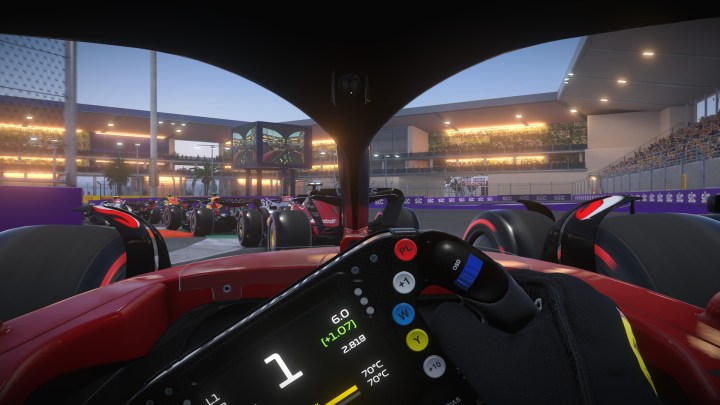
With most annualized games, there’s not too much to get excited about with a new year’s entry. Some new features and slightly tweaked visuals can be a nice touch, but the churn of yearly releases usually prevents franchises like Madden from delivering sweeping updates between years.
F1 22 is bucking against that trend with its full VR support. PC players will be able to experience the entire game through supported headsets like the Quest 2 for the first time ever. Based on a VR demo I played at Summer Game Fest, that’s a significant addition to the series. F1 22 in VR feels like the ultimate “dad game” — one that amps up the simulation experience for those who don’t mind investing in an in-depth tech set-up.
Enter the cockpit
My demo wasn’t exactly an experience that most players will have access to. EA had a top-tier racing set-up at the show, featuring a high-end wheel with realistic feedback, pedals, and racing chair. The pièce de résistance, of course, was a Quest 2 headset, which put me directly in the cockpit.
Mercifully, EA kept the controls simple for the demo, so I’d only have to worry about managing my speed and turning. I was placed on a standard F1 track and was free to ride around in first-person, using the game’s dynamic racing line to help me regulate my speed.

The F1 series is already known for its authentic simulation experience, but VR brings a different level of realism to it. Usually, I hate playing racing games in first-person, opting for a third-person view of my car. In VR, that perspective becomes much more appealing. I was peeking out of my side windows to better see upcoming turns, craning just a bit in my seat to see over my tires, and even stopping to look up at the sky (something that led to a few crashes, as you’d expect).
Of course, none of that would work as well as it does if the core racing wasn’t rock solid. Developer Codemasters is one of the best in the business when it comes to racing titles and that was immediately clear when playing my demo. I wasn’t thinking about controls or game mechanics at all; I felt like I was racing, not gaming.

With its VR support, F1 22 seems like the kind of game that’ll especially benefit those who invest in niche simulation setups — hence, the kind of hobbyist dads who go wild over flight simulators and racing games. Games like F1 are at their best the more they remove the barrier between reality and video game. Even without a fancy wheel or seat, the VR support goes a long way towards removing that last bit of friction.
I walked away from my demo feeling like that stereotypical dad, daydreaming about what I’d need to buy to build the ultimate home cockpit. Though even without that, I feel like the headset alone really amps up the sense of realism. I can’t really imagine playing it any other way.
I’m hoping that F1 22‘s VR support will be here to stay, but the game’s developers note that it’ll depend on the adoption rate. It has been a heavily requested feature for years, but it’s unclear how that’ll translate into actual players. Those who do buy in, however, will get to play the entire game in VR, which should make this one of the most robust VR titles on the market come launch. That alone makes F1 22 much more appealing than your usual annual upgrade.
F1 22 launches on July 1 for PS4, PS5, Xbox One, Xbox Series X/S, and PC. The VR support is only available on PC.



